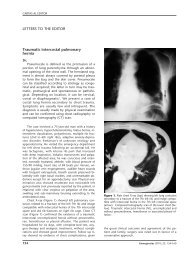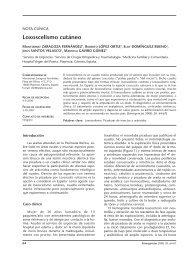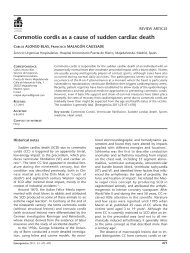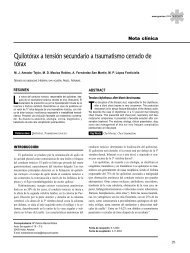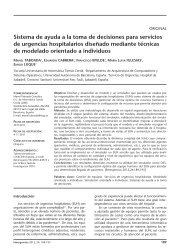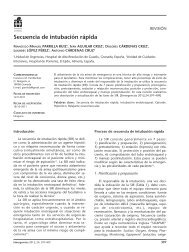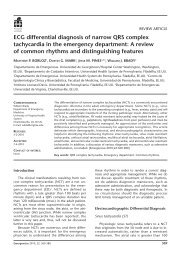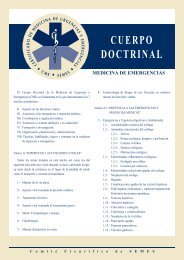Complete text PDF - Semes
Complete text PDF - Semes
Complete text PDF - Semes
You also want an ePaper? Increase the reach of your titles
YUMPU automatically turns print PDFs into web optimized ePapers that Google loves.
BRIEF REPORTS<br />
Diagnostic agreement between a comprehensive,<br />
fast-track community hospital emergency department<br />
and the corresponding referral hospital<br />
FRANCISCO JOSÉ MELLADO VERGEL 1 , NORBERTO DÍAZ RICOMÁ 1 , DIEGO MENA PARRA 1 ,<br />
FERNANDO ROSELL ORTIZ 2 , ANTONIA MARÍA CONTRERAS RODRÍGUEZ 1 , LAURA LEÓN RUIZ 3<br />
1 Hospital de Alta Resolución El Toyo. Empresa Pública Hospital de Poniente de Almería. Consejería de Salud<br />
de la Junta de Andalucía. Almería, Spain. 2 Empresa Pública Emergencias Sanitarias. Almería, Spain. 3 Complejo<br />
Hospitalario Torrecárdenas. Almería, Spain.<br />
CORRESPONDENCE:<br />
Dr. Francisco José Mellado Vergel<br />
C/Grecia, 110<br />
040009 Almería, Spain.<br />
E-mail:<br />
franciscojose.mellado@ephpo.es<br />
fjmelladov@hotmail.com<br />
RECEIVED:<br />
7-5-2010<br />
ACCEPTED:<br />
11-5-2010<br />
CONFLICT OF INTERES:<br />
None<br />
Introduction<br />
Diagnostic error is one of the main adverse<br />
events that can occur in hospitalized patients.<br />
Emergency departments, with increasingly high<br />
demand for services in recent years 1-5 are one of<br />
the high-risk areas 6 . Surveillance systems to monitor<br />
these errors are notably absent in most centres,<br />
nor are there standard values establishing<br />
what constitutes an acceptable rate of misdiagnosis<br />
in emergency departments 7 .<br />
The emergency department (ED) of the “Hospital<br />
de Alta Resolución El Toyo”, a comprehen-<br />
Objectives: To assess between-hospital agreement on diagnoses for patients transferred<br />
from a "high resolution" (comprehensive, fast-track) community hospital to the<br />
corresponding referral hospital, analyzing the rate of diagnostic error, epidemiologic<br />
factors related to error, reasons for error, and influence on in-hospital mortality.<br />
Methods: Diagnoses for patients transferred in 2009 were studied. Agreement was<br />
analyzed in 2 categories: 1) diagnosis within the correct syndrome grouping, whether<br />
strictly coincident or not, and 2) incorrect diagnosis. Variables compared were age, sex,<br />
the hospital department ordering the transfer, and diagnosis. The main reason for error<br />
was investigated.<br />
Results: A total of 1494 patients were transferred to the referral hospital. The mean (SD)<br />
age of transferred patients was 41.6 (30) years; 56% were men. Ninety-one percent<br />
were sent from the emergency department. The most frequent diagnostic groups were<br />
trauma (27%), internal medicine (25.8%), surgery (20.2%), and pediatrics (9.7%). There<br />
was diagnostic agreement in 91.8% of the cases. The most common reasons for error<br />
were insufficient clinical evaluation (69.7%), and misinterpretation of radiographs<br />
(21.3%). Age was associated with lack of diagnostic agreement (P=.003). No deaths<br />
occurred as a result of lack of agreement.<br />
Conclusions: In general, there was diagnostic agreement; the error rate was 8.2%. Sex,<br />
origin of the transfer order, and diagnostic group were unrelated to error; younger<br />
patient age was related to lack of agreement. The main reason for error was inadequate<br />
clinical evaluation. There were no deaths among patients for whom there was diagnostic<br />
disagreement. [Emergencias 2010;22:282-285]<br />
Key words: Diagnostic agreement. Diagnostic error. Mortality. Hospital emergency<br />
health services.<br />
sive, fast-track community hospital, is staffed by<br />
family physicians trained in accident and emergency<br />
medicine, with a laboratory, radiology and<br />
CT service, and a radiologist (conventional physically<br />
present on weekdays, telemedicine at other<br />
times), without any other specialist being physically<br />
present. The service consists of an ED with<br />
consultation and rapid treatment room, and a<br />
multipurpose area that functions as a short stay<br />
unit. For specialized assessment and/or other<br />
diagnostic tests, the patient is transferred to their<br />
referral hospital (Torrecárdenas Hospital Complex).<br />
282 Emergencias 2010; 22: 282-285
DIAGNOSTIC AGREEMENT BETWEEN A COMPREHENSIVE, FAST-TRACK COMMUNITY HOSPITAL EMERGENCY DEPARTMENT<br />
We studied the group of patients attended at<br />
our ED and then transferred to the referral hospital<br />
in the year 2009, in order to determine the<br />
degree of agreement between our ED diagnosis<br />
and the definitive discharge diagnosis, and analyzed:<br />
a) the rate of misdiagnosis, b) possible relationship<br />
between misdiagnosis and epidemiological<br />
variables, c) the primary reasons for error, and<br />
d) possible mortality associated with these errors.<br />
Method<br />
We performed a prospective, observational, cohort<br />
study. The study population consisted of patients<br />
referred from our ED to the reference hospital<br />
during the year 2009. From the emergency<br />
medical history we gathered data on age, sex, origin<br />
of transfer and ED diagnosis. We then compared<br />
this diagnosis with that in the report from<br />
the referral hospital concerned. The diagnoses<br />
were coded according to International Classification<br />
of Diseases, 9th Edition, Clinical Modification.<br />
We considered diagnostic agreement as being the<br />
same diagnosis or, if not exactly the same, the<br />
syndrome was correctly identified, requiring action<br />
and/or tests not available at our hospital. Otherwise,<br />
the diagnosis was considered erroneous. In<br />
cases of misdiagnosis, we reviewed in detail the<br />
medical history and laboratory tests to determine<br />
if the reason for the error lay primarily in: a) inadequate<br />
clinical assessment (background, symptoms<br />
or signs, physical examination), b) radiological interpretation,<br />
c) laboratory analytical interpretation)<br />
electrocardiographic interpretation (in this group<br />
we analyzed cases to assess the impact of such interpretation<br />
on the treatment administered).<br />
We compared the variables analyzed for the<br />
group with and without diagnostic agreement.<br />
Descriptive analysis was performed using univariate<br />
and multivariate binary logistic regression.<br />
Results<br />
During the study period, a total of 50,461<br />
emergency patients were attended; 1,598 (3.2%)<br />
were transferred, of whom 1,494 (93%) were<br />
transferred. The remaining 104 patients were<br />
mainly those who used their own means and subsequently<br />
consulted a specialist (ophthalmology,<br />
otolaryngology and pediatrics), but also those erroneously<br />
identified (mainly foreigners) and patients<br />
who ultimately decided not to attend the<br />
referral hospital. The reasons for transfer were to<br />
undergo specialized assessment and/or other diagnostic<br />
tests (imaging tests, invasive procedures<br />
or specific analytical microbiology).<br />
The mean age was 41.6 ± 30.0 years, 56%<br />
were male. As for the origin of transfer, the ED<br />
transferred 1,359 (91%) and the multi-purpose<br />
area 135 (9%). Diagnostic groups were distributed<br />
as follows: trauma 403 (27%), internal<br />
medicine 386 (25.8%), surgery 302 (20.2%), pediatrics<br />
145 (9.7%), gynecology 118 (7 9%), ophthalmology<br />
104 (7%) and otolaryngology 36<br />
(2.4%). There was diagnostic agreement in 1,372<br />
(91.8%) of the cases (87.2% coincided and<br />
12.8% had correct identification of the syndrome),<br />
and 122 (8.2%) discordant diagnoses.<br />
The reasons for diagnostic error were inadequate<br />
clinical assessment in 85 cases (69.7%), radiological<br />
interpretation in 26 (21.3%), analytical interpretation<br />
in 7 (5.7%) and electrocardiographic interpretation<br />
in 4 (3.3%) cases.<br />
Table 1 lists the most common discordant diagnoses,<br />
grouped according to type of error.<br />
There were no deaths in this group of patients<br />
without diagnostic agreement.<br />
Univariate analysis of the groups with and<br />
without diagnostic agreement is shown in Table<br />
2. The group without diagnostic agreement was<br />
younger, most commonly referred from the ED,<br />
and belonging to the pediatric diagnostic group.<br />
Table 1. Most frequent suspected diagnoses categorized according to reasons for error in the 122 patients without final diagnostic<br />
agreementwith the referral hospital<br />
Error in clinical assessment Radiological error Analytical error ECG error<br />
N = 85 (69,7%) N = 26 (21,3%) N = 7 (5,7%) N = 4 (3,3%)<br />
Soft tissue injury (11) Limb fracture (19) Respiratory infection (2) Arrhythmias (4)<br />
Infection in children (7) Vertebral fracture (3) Miscellaneous (5)<br />
Acute abdomen (6)<br />
Upper gastrointestinal bleeding (4)<br />
Acute coronary syndrome (4)<br />
Gastrointestinal disorders in children (4)<br />
Stroke (3)<br />
Ear disease (3)<br />
Miscellaneous * (43)<br />
Miscellaneous (4)<br />
*By specialties: surgery (12), internal medicine (8), pediatrics (7), ophthalmology (7), trauma (3), gynecology (3) otolaryngology (3). ECG: electrocardiography.<br />
Emergencias 2010; 22: 282-285 283
F. J. Mellado Vergel et al.<br />
Table 2. Univariate analysis in patient groups with and without diagnostic agreement<br />
Variables DA (N = 1.372) No DA (N = 122) p OR (IC95%)<br />
Age, mean ± SD 42.2 ± 24.7 35.2 ± 26.8 < 0.05<br />
Sex, n (%) 0.24<br />
Male 761 (55.5) 75 (61) 1 (reference)<br />
Female 609 (44.5) 48 (39) 0.8 (0.548-1.167)<br />
Origin of transfer, n (%) < 0.05<br />
ED 1.241 (90.5) 118 (95.9) 1 (reference)<br />
Multipurpose area<br />
Diagnostic groups, n (%)<br />
130 (9.5) 5 (4.1) 0.404 (0.162-1.008)<br />
Traumatology 367 (26.8) 36 (29.3) 0.55 1.132 (0.754-1.700)*<br />
Internal Medicine 357 (26) 29 (23.6) 0.55 0.876 (0.568-1.352)*<br />
Surgery 280 (20.4) 22 (17.9) 0.50 0.849 (0.525-1.371)*<br />
Pediatrics 124 (9) 21 (17.1) < 0.05 2.070 (1.250-3.429)*<br />
Gynecology 114 (8.3) 4 (3.3) 0.46 0.371 (0.134-1.022)*<br />
Ophthalmology 97 (7.1) 7 (5.7) 0.56 0.793 (0.360-1.747)*<br />
Otolaryngology 32 (2.3) 4 (3.3) 0.52 1.407 (0.489-4.04)*<br />
DA: diagnostic agreement. OR: odds ratio. CI: confidence interval. *The reference category is constituted by other patients.<br />
Binary logistic regression with these three variables<br />
was performed, and only age remained a<br />
significant variable, so the group of patients without<br />
diagnostic agreement were younger.<br />
Discussion<br />
With nearly 1,500 patients, the cohort analyzed<br />
is the largest published to date in Spain. It also has<br />
the peculiarity of including a wide range of diagnostic<br />
categories, covering many different specialties,<br />
and an age range from childhood to old age.<br />
A comparison of the diagnoses between our<br />
ED and the referral hospital showed a misdiagnosis<br />
rate of 8.2%. There is no established value<br />
against which to measure the quality of diagnosis<br />
of our center. The only reference values available<br />
are from previous studies that used different samples<br />
and methods of analysis, with a rate of misdiagnosis<br />
that varies widely, from a low 0.6% 11<br />
4.6% 7 , 10.7% 5 , 14.6% 12 , and up to 19.7% 4 .<br />
A very important finding was that there were<br />
no deaths among any of the patients with no<br />
diagnostic agreement, a key factor in assessing<br />
health outcomes after medical errors.<br />
According to our results, sex, origin of transfer<br />
and diagnostic groups are not related to erroneous<br />
diagnoses, only age remained associated<br />
with no diagnostic agreement, a fact not found in<br />
other studies, where age was unrelated 7 , or increased<br />
age was associated with misdiagnosis, as<br />
in the work of Miret et al. 4 , but in this study the<br />
population studied presented advanced middle<br />
age (73 years). As for the different diagnostic<br />
groups, several studies have linked error with a<br />
wide variety of diagnoses 11-16 .<br />
As regards the reasons for error in our series,<br />
the main cause (69.7%) was inadequate clinical<br />
assessment, as found in other similar studies 4,7,11<br />
with percentages between 40 and 55%. However,<br />
as indicated by Tudela et al. 7 , to interpret these<br />
results we must also consider the possibility that<br />
the initial clinical assessment was not incorrect,<br />
but in some cases the evolution of the disease involved<br />
increasing expressiveness and the final diagnosis<br />
only became evident after admission to<br />
the referral hospital. Errors of radiographic interpretation<br />
17 were the second most common cause<br />
of error, and in our series they occurred predominantly<br />
when the diagnosis was trauma. As for errors<br />
in electrocardiographic interpretation, the<br />
four errors in our study were merely in classifying<br />
the type of arrhythmia, with no impact on the<br />
treatment administered.<br />
With these results it seems reasonable to suggest<br />
that a systematic clinical and radiological assessment<br />
and careful diagnosis could improve accuracy.<br />
The combination of experienced clinical professionals<br />
with more time for patient care and less<br />
ED workload could help to improve diagnostic<br />
agreement 7 .<br />
Certain limitations of our study should be noted;<br />
first, 7% of patients transferred to the referral<br />
hospital were lost to follow up, but on review it<br />
was found that these were cases of low morbidity<br />
and attended the referral hospital or other specialists<br />
using their own means. Second, the gold<br />
standard was the final diagnosis of the referral<br />
hospital, supported by the main criteria for referral,<br />
but this could occasionally be incorrect. Third,<br />
the limited number of cases in the group with no<br />
diagnostic agreement could have influenced some<br />
of our results.<br />
Finally, further studies on diagnostic agreement<br />
are required to establish acceptable limits, taking<br />
into account the peculiarities of each centre. Such<br />
284 Emergencias 2010; 22: 282-285
surveillance systems serve to improve the relationship<br />
between different levels of care, undergo<br />
joint training activities and improve the quality of<br />
patient care 4 .<br />
References<br />
DIAGNOSTIC AGREEMENT BETWEEN A COMPREHENSIVE, FAST-TRACK COMMUNITY HOSPITAL EMERGENCY DEPARTMENT<br />
1 Millá J. Urgencias médicas: algo más que una serie televisiva. Med<br />
Clin (Barc). 2001;117:295-6.<br />
2 Sieck S. The evolution of a new standard of hospital care. Paradigmshift<br />
to the emergency department and the role of point of care<br />
testing. Point of Care. 2006;5:2-5.<br />
3 Sánchez López A, Bueno Cavanillas A. Factores asociados al uso inadecuado<br />
de un servicio de urgencias hospitalario. Emergencias. 2005;17:138-44.<br />
4 Mirete C, López-Bayo L, Blázquez JC, Rodríguez-Rodriguez P, Serrano<br />
MI, De Teresa L. El error diagnóstico en el área de ingresos de un<br />
hospital de media-larga estancia. Estudio de concordancia diagnóstica.<br />
Rev Esp Geriatr Gerontol. 2005;40:195-8.<br />
5 Estella A, Pérez-Bello L, Sánchez JI, Toledo MD, Del Águila D. Actividad<br />
asistencial en la unidad de observación de un hospital de segundo<br />
nivel. Emergencias. 2009;21:95-8.<br />
6 Weingart SN, Wilson R, Gibberd RW, Harrison B. Epidemiology of<br />
medical error. BMJ. 2000;320:774-7.<br />
7 Tudela P, Mòdol JM, Veny A, Tor J, Bonet M, Rego MJ. Estudio de la concordancia<br />
diagnóstica entre el área médica de urgencias y la de hospitalización<br />
en un hospital general. Med Clin (Barc). 2002;119:531-3.<br />
8 Rodríguez-Caravaca G, Villar del Campo I. Concordancia diagnóstica<br />
entre atención primaria y atención especializada tras consulta urgente.<br />
Aten Primaria. 2000;25:292-6.<br />
9 Fernández-Cotrina JM, García-Ruiz AJ, Márquez-Castilla M, Jiménez-<br />
Guerrero O, Reina-Caballero E, Bocanegra-Pérez A, et al. Acuerdo<br />
diagnóstico entre equipos de emergencias y servicios hospitalarios.<br />
Gac Sanit. 2004;18:458-63.<br />
10 Carrasco JL, Jover L. Métodos estadísticos para evaluar la concordancia.<br />
Med Clin (Barc). 2004;122(Supl 1):28-34.<br />
11 Chellis M, Olson JE, Augustine J, Hamilton GC. Evaluation of missed<br />
diagnosis for patients admitted from the emergency department.<br />
Acad Emerg Med. 2001;8:125-30.<br />
12 Plaza S, Álvarez-Sala JL, García T, Montero J,González J, Montero E,<br />
et al. El error en el diagnóstico de urgencia. Estudio retrospectivo de<br />
1.233 historias clínicas. An Med Intern. (Madrid). 1987;4:171-6.<br />
13 Tudela P, Davant E, Monreal M, Segura A, Valencia J, Carreres A.<br />
Análisis clínico de la tromboembolia pulmonar no sospechada en el<br />
servicio de urgencias. Med Clin (Barc). 2000;114:292-3.<br />
14 Mòdol JM, Tudela P, Veny A, Sahuquillo JC, Tor J, Giménez M. Indicaciones<br />
y rendimiento diagnóstico de la punción lumbar en urgencias.<br />
Med Clin (Barc). 2002;118:10-2.<br />
15 Balaguer JV, Gabriel F, Braso JV, Núñez C, Catalá T, Labios M. El papel de<br />
la autopsia clínica en el control de calidad de los diagnósticos clínicos en<br />
una unidad de urgencias. An Med Intern. (Madrid). 1998;15:179-82.<br />
16 Famularo G, Salvini P, Terranova A, Gerace C. Clinical errors in emergency<br />
medicine: experience at the emergency department of an italian<br />
teaching hospital. Acad Emerg Med. 2000;7:1278-81.<br />
17 Urrutia A, Bechini J, Tor J, Olazábal A, Rey-Joly C. Evaluación de la interpretación<br />
de la radiografía de tórax por los médicos de guardia<br />
en un hospital universitario. Med Clin (Barc). 2001;117:323-33.<br />
Concordancia diagnóstica entre el servicio de urgencias de un hospital de alta resolución<br />
y su hospital de referencia<br />
Mellado Vergel FJ, Díaz Ricomá N, Mena Parra D, Rosell Ortiz F, Contreras Rodríguez AM, León Ruiz L<br />
Objetivos: Conocer la concordancia diagnóstica de los pacientes trasladados desde las urgencias de un hospital de alta<br />
resolución a su hospital de referencia, y analizar el índice de error diagnóstico, sus características epidemiológicas, los<br />
motivos fundamentales de error y su influencia en la mortalidad intrahospitalaria.<br />
Métodos: Se analizaron los pacientes trasladados durante el año 2009. Se establecieron 2 niveles de concordancia<br />
diagnóstica: 1º coincidente o bien no coincidente pero sindrómicamente correcta, y 2º errónea. Se compararon las variables:<br />
edad, sexo, origen de traslado y diagnóstico. Se determinó el motivo fundamental de error.<br />
Resultados: Se trasladaron al hospital de referencia 1.494 pacientes. La edad media fue de 41,6 ± 30 años, y el 56%<br />
fueron hombres. Desde urgencias se trasladaron el 91%. Los grupos diagnósticos más frecuentes fueron: traumatología<br />
27%, medicina interna 25,8%, cirugía 20,2% y pediatría 9,7%. La concordancia diagnóstica fue del 91,8%. Los motivos<br />
de error más frecuentes fueron una valoración clínica inadecuada (69,7%) y la interpretación radiológica (21,3%).<br />
La variable asociada al grupo de pacientes sin concordancia diagnóstica fue la edad (p = 0,003). No hubo ningún fallecimiento<br />
en los pacientes sin concordancia diagnóstica.<br />
Conclusiones: La concordancia diagnóstica fue mayoritaria con un índice de error del 8,2%. El sexo, el origen de traslado<br />
y los grupos diagnósticos no están relacionados con el error diagnóstico, sólo los pacientes de menor edad se<br />
asocian significativamente a la no concordancia diagnóstica. El motivo de error principal fue una inadecuada valoración<br />
clínica. No se registró mortalidad en el grupo de pacientes sin concordancia diagnóstica. [Emergencias<br />
2010;22:282-285]<br />
Palabras clave: Concordancia diagnóstica. Error diagnóstico. Mortalidad. Urgencias hospitalarias.<br />
Emergencias 2010; 22: 282-285 285



